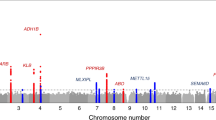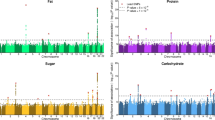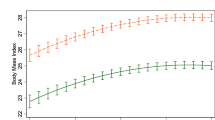Abstract
Background/Objective:
Exposure to food advertisements may cue overeating among children, especially among those genetically predisposed to respond to food cues. We aimed to assess how television food advertisements affect eating in the absence of hunger among children in a randomized trial. We hypothesized that the fat mass and obesity-associated gene (FTO) rs9939609 single-nucleotide polymorphism would modify the effect of food advertisements.
Subjects/Methods:
In this randomized experiment, 200 children aged 9–10 years were served a standardized lunch and then shown a 34-min television show embedded with either food or toy advertisements. Children were provided with snack food to consume ad libitum while watching the show and we measured caloric intake. Children were genotyped for rs9939609 and analyses were conducted in the overall sample and stratified by genotype. A formal test for interaction of the food advertisement effect on consumption by rs9939609 was conducted.
Results:
About 172 unrelated participants were included in this analysis. Children consumed on average 453 (s.d.=185) kcals during lunch and 482 (s.d.=274) kcals during the experimental exposure. Children who viewed food advertisements consumed an average of 48 kcals (95% confidence interval: 10, 85; P=0.01) more of a recently advertised food than those who viewed toy advertisements. There was a statistically significant interaction between genotype and food advertisement condition (P for interaction=0.02), where the difference in consumption of a recently advertised food related to food advertisement exposure increased linearly with each additional FTO risk allele, even after controlling for body mass index percentile.
Conclusions:
Food advertisement exposure was associated with greater caloric consumption of a recently advertised food, and this effect was modified by an FTO genotype. Future research is needed to understand the neurological mechanism underlying these associations.
This is a preview of subscription content, access via your institution
Access options
Subscribe to this journal
Receive 12 print issues and online access
$259.00 per year
only $21.58 per issue
Buy this article
- Purchase on Springer Link
- Instant access to full article PDF
Prices may be subject to local taxes which are calculated during checkout


Similar content being viewed by others
References
Ogden CL, Carroll MD, Flegal KM . Prevalence of obesity in the United States. JAMA 2014; 312: 189–190.
Dietz WH . Overweight in childhood and adolescence. N Engl J Med 2004; 350: 855–857.
Turer CB, Lin H, Flores G . Health status, emotional/behavioral problems, health care use, and expenditures in overweight/obese US children/adolescents. Acad Pediatr 2013; 13: 251–258.
Guo SS, Chumlea WC . Tracking of body mass index in children in relation to overweight in adulthood. Am J of Clin Nutr 1999; 70: 145S–148S.
Guyenet SJ, Schwartz MW . Regulation of food intake, energy balance, and body fat mass: implications for the pathogenesis and treatment of obesity. J Clin Endocrinol Metab 2012; 97: 745–755.
Lutter M, Nestler EJ . Homeostatic and hedonic signals interact in the regulation of food intake. J Nutr 2009; 139: 629–632.
Bassareo V, Di Chiara G . Modulation of feeding-induced activation of mesolimbic dopamine transmission by appetitive stimuli and its relation to motivational state. Eur J Neurosci 1999; 11: 4389–4397.
Bassareo V, Cucca F, Musio P, Lecca D, Frau R, Di Chiara G . Nucleus accumbens shell and core dopamine responsiveness to sucrose in rats: role of response contingency and discriminative/conditioned cues. Eur J Neurosci 2015; 41: 802–809.
Pavlov IP . Experimental psychology and psycho-pathology in animals. In: Lectures on Conditioned Reflexes: Twenty-Five Years of Objective Study of the Higher Nervous Activity (behaviour) of Animals Liverwright Publishing Corporation: New York, NY, USA 1928. pp 47–60.
Federal Trade Commission A Review of Food Marketing to Children and Adolescents: Follow-Up Report. Federal Trade Commission: Washington, DC, USA, 2012.
The Rudd Center for Food Policy Trends in Television Food Advertising. The Rudd Center for Food Policy: New Haven, CT, USA, 2010.
Dovey TM, Taylor L, Stow R, Boyland EJ, Halford JCG . Responsiveness to healthy television (TV) food advertisements/commercials is only evident in children under the age of seven with low food neophobia. Appetite 2011; 56: 440–446.
Halford JCG, Gillespie J, Brown V, Pontin EE, Dovey TM . Effect of television advertisements for foods on food consumption in children. Appetite 2004; 42: 221–225.
Halford JCG, Boyland EJ, Hughes G, Oliveira LP, Dovey TM . Beyond-brand effect of television (TV) food advertisements/commercials on caloric intake and food choice of 5–7-year-old children. Appetite 2007; 49: 263–267.
Halford JCG, Boyland EJ, Hughes GM, Stacey L, McKean S, Dovey TM . Beyond-brand effect of television food advertisements on food choice in children: the effects of weight status. PHN 2008; 11: 897–904.
Harris JL, Bargh JA, Brownell KD . Priming effects of television food advertising on eating behavior. Health Psychol 2009; 28: 404–413.
Anschutz DJ, RCME Engels, Van Strien T . Side effects of television food commercials on concurrent nonadvertised sweet snack food intakes in young children. Am J Clin Nutr 2009; 89: 1328–1333.
Anschutz DJ, RCME Engels, Van Strien T . Maternal encouragement to be thin moderates the effect of commercials on children's snack food intake. Appetite 2010; 55: 117–123.
Boyland EJ, Harrold JA, Dovey TM, Allison M, Dobson S, Jacobs MC et al. Food choice and overconsumption: effect of a premium sports celebrity endorser. J Pediatr 2013; 163: 339–343.
Anderson GH, Khodabandeh S, Patel B, Luhovyy BL, Bellissimo N, Mollard RC . Mealtime exposure to food advertisements while watching television increases food intake in overweight and obese girls but has a paradoxical effect in boys. Appl Physiol Nutr Metab 2015; 40: 162–167.
Gorn GJ, Goldberg ME . Children's responses to repetitive television commercials. J Consum Res 1980; 6: 421–424.
Frayling TM, Timpson NJ, Weedon MN, Zeggini E, Freathy RM, Lindgren CM et al. A common variant in the FTO gene is associated with body mass index and predisposes to childhood and adult obesity. Science 2007; 316: 889–894.
Loos RJF, Yeo GSH . The bigger picture of FTO-the first GWAS-identified obesity gene. Nat Rev Endocrinol 2014; 10: 51–61.
Tanofsky-Kraff M, Han JC, Anandalingam K, Shomaker LB, Columbo KM, Wolkoff LE et al. The FTO gene rs9939609 obesity-risk allele and loss of control over eating. Am J of Clin Nutr 2009; 90: 1483–1488.
Wardle J, Carnell S, Haworth CMA, Farooqi IS, O'Rahilly S, Plomin R . Obesity associated genetic variation in FTO is associated with diminished satiety. J Clin Endocrinol Metab 2008; 93: 3640–3643.
Wardle J, Sanderson S . The FTO gene and measured food intake in children. Int J Obes 2009; 33: 42–45.
Karra E, O'Daly OG, Choudhury AI, Yousseif A, Millership S, Neary MT et al. A link between FTO, ghrelin, and impaired brain food-cue responsivity. J Clin Invest 2013; 123: 3539–3551.
Agriculture USDO. USDA National Nutrient Database for Standard Reference. Available at: http://www.ars.usda.gov/Services/docs.htm?docid=8964 (accessed on August 2014).
Fisher JO, Birch L . Eating in the absence of hunger and overweight in girls from 5 to 7 y of age. Am J of Clin Nutr 2002; 76: 226–231.
Lansigan RK, Emond JA, Gilbert-Diamond D . Understanding eating in the absence of hunger among young children: a systematic review of existing studies. Appetite 2015; 85: 36–47.
Centers for Disease Control and Prevention. CDC Growth Charts: United States. Washington, DC, USA 2000 Available at: http://www.cdc.gov/growthcharts/.
Institute of Medicine (U.S.) Dietary Reference Intakes for Energy, Carbohydrate, Fiber, Fat, Fatty Acids, Cholesterol, Protein, and Amino Acids. National Academies Press: Washington, D.C, USA, 2005.
Birch L, Fisher JO, Grimm-Thomas K, Markey CN, Sawyer R, Johnson SL . Confirmatory factor analysis of the Child Feeding Questionnaire: a measure of parental attitudes, beliefs and practices about child feeding and obesity proneness. Appetite 2001; 36: 201–210.
Powell LM, Schermbeck RM, Chaloupka FJ . Nutritional content of food and beverage products in television advertisements seen on children's programming. Child Obes 2013; 9: 524–531.
Berthoud H-R . Homeostatic and non-homeostatic pathways involved in the control of food intake and energy balance. Obesity 2006; 14 (Suppl 5): 197S–200S.
Zahm DS . An integrative neuroanatomical perspective on some subcortical substrates of adaptive responding with emphasis on the nucleus accumbens. Neurosci Biobehav Rev 2000; 24: 85–105.
Rapuano KM, Huckins JF, Sargent JD, Heatherton TF, Kelley WM . Individual differences in reward and somatosensory-motor brain regions correlate with adiposity in adolescents. Cereb Cortex 2016; 26: 2602–2611.
Sevgi M, Rigoux L, Kühn AB, Mauer J, Schilbach L, Hess ME et al. An obesity-predisposing variant of the FTO gene regulates D2R-dependent reward learning. J Neurosci 2015; 35: 12584–12592.
Boyland EJ, Nolan S, Kelly B, Tudur-Smith C, Jones A, Halford JC et al. Advertising as a cue to consume: a systematic review and meta-analysis of the effects of acute exposure to unhealthy food and nonalcoholic beverage advertising on intake in children and adults. Am J of Clin Nutr 2016; 103: 519–533.
Birch L, Fisher JO, Davison KK . Learning to overeat: maternal use of restrictive feeding practices promotes girls' eating in the absence of hunger. Am J of Clin Nutr 2003; 78: 215–220.
Faith MS, Scanlon KS, Birch L, Francis LA, Sherry B . Parent-child feeding strategies and their relationships to child eating and weight status. Obes Res 2004; 12: 1711–1722.
Ventura AK, Birch L . Does parenting affect children's eating and weight status? Int J Behav Nutr Phys Act 2008; 5: 15.
Fisher JO, Birch L . Restricting access to palatable foods affects children's behavioral response, food selection, and intake. Am J of Clin Nutr 1999; 69: 1264–1272.
Matheson DM, Killen JD, Wang Y, Varady A, Robinson TN . Children's food consumption during television viewing. Am J of Clin Nutr 2004; 79: 1088–1094.
AKTAŞ ARNAS Y . The effects of television food advertisement on children's food purchasing requests. Pediatr Int 2006; 48: 138–145.
Galst JP, White MA . The unhealthy persuader: the reinforcing value of television and children's purchase-influencing attempts at the supermarket. Child Dev 1976; 47: 1089.
Folkvord F, Anschutz DJ, Buijzen M, Valkenburg PM . The effect of playing advergames that promote energy-dense snacks or fruit on actual food intake among children. Am J Clin Nutr 2013; 97: 239–245.
Folkvord F, Anschutz DJ, Nederkoorn C, Westerik H, Buijzen M . Impulsivity, ‘advergames,’ and food intake. Pediatrics 2014; 133: 1007–1012.
Harris JL, Schwartz MB, Brownell KD . Marketing foods to children and adolescents: licensed characters and other promotions on packaged foods in the supermarket. PHN 2010; 13: 409–417.
Acknowledgements
This study was supported by grant R21HD076097 from the Eunice Kennedy Shriver National Institute of Child Health and Human Development (NIH) (Dr Gilbert-Diamond); by grant R01DA022582 from the National Institute of Drug Addiction (NIH) (Heatherton); by grant R01CA077026 from the National Cancer Institute (NIH) (Sargent); by grant R01AA021347 from the National Institute of Alcohol Abuse and Alcoholism (NIH) (Sargent); by grant NIHGMS P20GM104416 from the NIH (Dr Karagas); by grant ES022832 from the National Institute of Environmental Health Sciences (NIH) (Dr Karagas); and by grant RD83544201 from the Environmental Protection Agency (Dr Karagas). The funding sources had no role in the design and conduct of the study; collection, management, analysis and interpretation of the data; preparation, review or approval of the manuscript; and decision to submit the manuscript for publication.
Author Contributions
Dr G-D had full access to the data and takes full responsibility for the integrity of the data and the accuracy of the data analysis. Study concept and design: G-D, RKL, WMK, TFH, JDS. Acquisition of data: G-D, RKL, KMR. Analysis and interpretation of data: G-D, JAE, JDS. Drafting of the manuscript: G-D, JAE. Critical revision of the manuscript for important intellectual content: All the authors. Statistical analysis: G-D, JAE. Obtaining funding: G-D, TFH, JDS. Administrative, technical or material support: RKL. Study supervision: G-D.
Additional Contributions
Participating children and their caregivers enabled this research study to happen. Horacio Romero Castillo, Archana Ramanujam and other study staff members contributed significantly to running this study. Margaret R Karagas, Department of Epidemiology, Geisel School of Medicine at Dartmouth, obtained additional funding for this study.
Author information
Authors and Affiliations
Corresponding author
Ethics declarations
Competing interests
The authors declare no conflict of interest.
Additional information
Supplementary Information accompanies this paper on International Journal of Obesity website
Supplementary information
Rights and permissions
About this article
Cite this article
Gilbert-Diamond, D., Emond, J., Lansigan, R. et al. Television food advertisement exposure and FTO rs9939609 genotype in relation to excess consumption in children. Int J Obes 41, 23–29 (2017). https://doi.org/10.1038/ijo.2016.163
Received:
Revised:
Accepted:
Published:
Issue Date:
DOI: https://doi.org/10.1038/ijo.2016.163
This article is cited by
-
A comparative analysis of unhealthy food and beverage television advertising to children in Thailand, between 2014 and 2022
Globalization and Health (2024)
-
Elucidating pathways to pediatric obesity: a study evaluating obesity polygenic risk scores related to appetitive traits in children
International Journal of Obesity (2024)
-
RETRACTED ARTICLE: Childhood obesity risk increases with increased screen time: a systematic review and dose–response meta-analysis
Journal of Health, Population and Nutrition (2023)
-
The association between screen use and central obesity among children and adolescents: a systematic review and meta-analysis
Journal of Health, Population and Nutrition (2023)
-
Heightened sensitivity to high-calorie foods in children at risk for obesity: insights from behavior, neuroimaging, and genetics
Brain Imaging and Behavior (2023)



